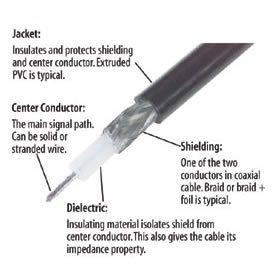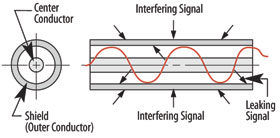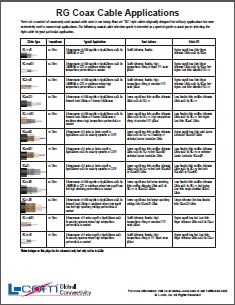RG-style Coaxial Cable
(blogger@L-com.com)
Following our popular post about Antenna Coax Cable Types where we talked about the low-loss style coaxial cable used in antennas, we wanted to spend a moment talking about the RG-style coaxial cable.
RG is sometimes attributed to mean "Radio Guide". The different standard RG numbers were originally set by the US government long ago. In fact, the actual letters stood for:
- R = "Radio Frequency"
- G = "Government"
- U = "Universal Specification"
- A, B, C, etc., = Added after the standard number to indicate a modification from the original standard, such as to change the center conductor from solid to stranded to improve flexibility
So, a cable referred to as RG188A/U is really the universal standard 188, with modification "A", set up by the government for radio frequency use. Today, RG references are no longer precise and are more of a general reference. Individual vendors may have slightly varied specs for the same RG cable, so it is important to understand those specs for your application.
What is Coaxial Cable?

It's probably a good idea to start with an explanation of what coaxial cable really is. The design was created to take advantage of radio frequency waves and contain them through a cable to provide a communication signal. To do that, an engineer designed a cable with two axis separated by a "dielectric", usually made of plastic, so that the wave could run between them. In coaxial cable, there is always a center or inner conductor and an outer conductor that is often just called the shield. The thickness and density of the dielectric aids in controlling the wavelength and impedance of the cable.
Differences between RG-style and Low-loss style

One of the first concepts that is important to RG-style coax is impedance. All coaxial cables, including low-loss styles, have impedances, which is an idealized measurement of the resistance to the flow of the current. Since conditions shift along the length of the cable, coaxial cables are usually referred to by their characteristic impedance. Low-loss cables almost always have a ~50 Ohm impedance. RG-style coax can vary, but the most common are ~50 Ohm and ~75 Ohm. Usually, the 50 Ohm cables are used in various forms of data communication, while the 75 Ohm cables are used in video or audio transmission.
Beyond impedance, low-loss coax and RG-style coax look very similar. They usually can be terminated with the same type of connectors (though the connectors must be designed for the particular coaxial size in order to fit), and both styles include a broad range of outer diameters and weights. However, there is a clear difference in the attenuation of the two different styles, especially at higher 
Applications
So if it isn't for wireless, what can you do with RG-style coax? There are actually a range of applications for which RG-style is best, usually involving high to ultra-high frequencies (HF to UHF). A few examples include home entertainment, GPS systems, CCTV and security video, and various forms of telecommunications. L-com provides a broader explanation on its coaxial tutorial page, as well as a downloadable pdf RG guide that breaks down the most common RG types.
Learn more
There are a lot of resources available online for more information:
Blog post: Antenna Coaxial Cable Types
http://lcomproducts.blogspot.com/2012/06/antenna-coaxial-cable-types.html
RG Coax Cable Applications (pdf download)
http://www.l-com.com/content/rg-coax-cable-applications.pdf
Newsletter: Coaxial Products to Fill Every Need
http://www.l-com.com/content/Article.aspx?Type=N&ID=9685
Newsletter: Tips on Selecting the Right Coaxial Cable
http://www.l-com.com/content/Article.aspx?Type=N&ID=9671
Newsletter: Coaxial Connectors 101
http://www.l-com.com/content/Article.aspx?Type=N&ID=9474
Newsletter: Coaxial Crimping Tools
http://www.l-com.com/content/Article.aspx?Type=N&ID=9473
Newsletter: Coaxial Cabling - What is it and where is it used?
http://www.l-com.com/content/Article.aspx?Type=N&ID=110
Coaxial Cable Tutorial
http://www.l-com.com/content/Coaxial-Cabling-Tutorial.html
Quick note: L-com stocks a wide range of RG-style coaxial cable assemblies, connectors, and bulk cable, along with most adapters and couplers, terminators, tools, kits, and wall plates on its Coaxial Product Center. If you know the connector and bulk cable types, you can also use their Cable Assemblies Product Wizard to zero in on the part you need.

No comments:
Post a Comment